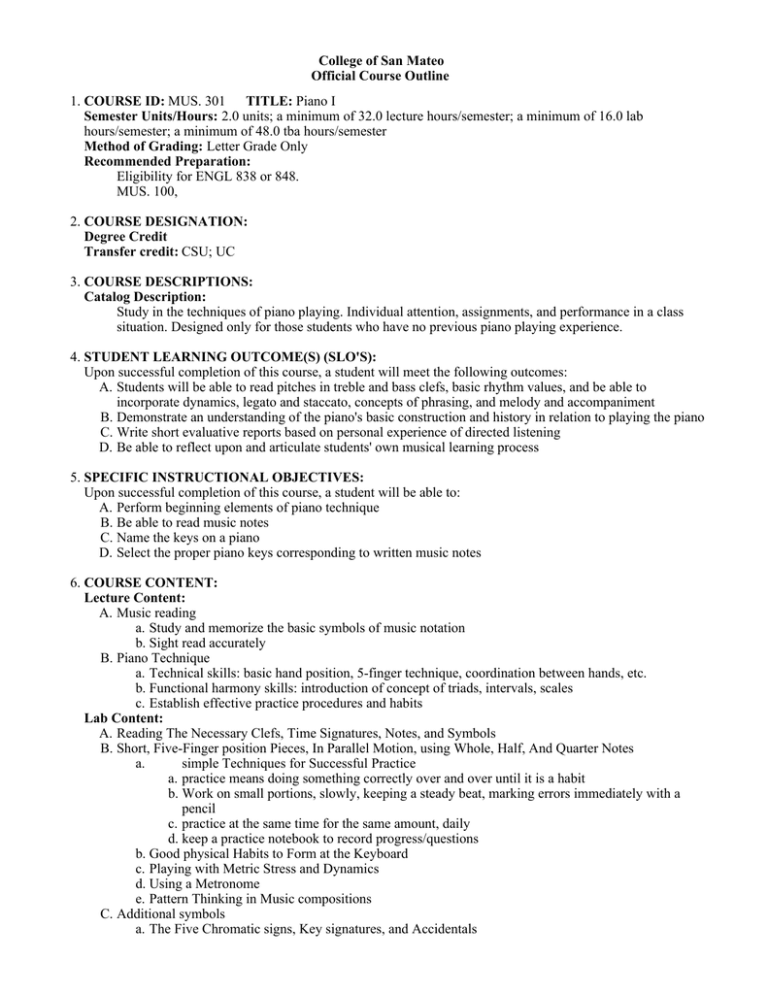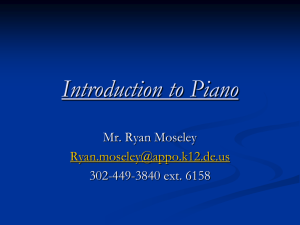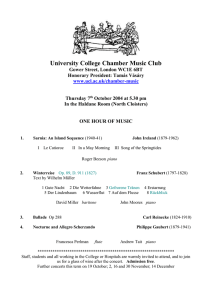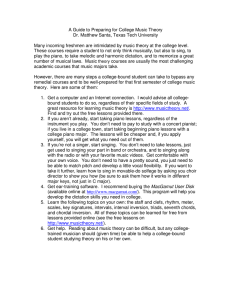College of San Mateo Official Course Outline COURSE ID: Semester Units/Hours:
advertisement

College of San Mateo Official Course Outline 1. COURSE ID: MUS. 301 TITLE: Piano I Semester Units/Hours: 2.0 units; a minimum of 32.0 lecture hours/semester; a minimum of 16.0 lab hours/semester; a minimum of 48.0 tba hours/semester Method of Grading: Letter Grade Only Recommended Preparation: Eligibility for ENGL 838 or 848. MUS. 100, 2. COURSE DESIGNATION: Degree Credit Transfer credit: CSU; UC 3. COURSE DESCRIPTIONS: Catalog Description: Study in the techniques of piano playing. Individual attention, assignments, and performance in a class situation. Designed only for those students who have no previous piano playing experience. 4. STUDENT LEARNING OUTCOME(S) (SLO'S): Upon successful completion of this course, a student will meet the following outcomes: A. Students will be able to read pitches in treble and bass clefs, basic rhythm values, and be able to incorporate dynamics, legato and staccato, concepts of phrasing, and melody and accompaniment B. Demonstrate an understanding of the piano's basic construction and history in relation to playing the piano C. Write short evaluative reports based on personal experience of directed listening D. Be able to reflect upon and articulate students' own musical learning process 5. SPECIFIC INSTRUCTIONAL OBJECTIVES: Upon successful completion of this course, a student will be able to: A. Perform beginning elements of piano technique B. Be able to read music notes C. Name the keys on a piano D. Select the proper piano keys corresponding to written music notes 6. COURSE CONTENT: Lecture Content: A. Music reading a. Study and memorize the basic symbols of music notation b. Sight read accurately B. Piano Technique a. Technical skills: basic hand position, 5-finger technique, coordination between hands, etc. b. Functional harmony skills: introduction of concept of triads, intervals, scales c. Establish effective practice procedures and habits Lab Content: A. Reading The Necessary Clefs, Time Signatures, Notes, and Symbols B. Short, Five-Finger position Pieces, In Parallel Motion, using Whole, Half, And Quarter Notes a. simple Techniques for Successful Practice a. practice means doing something correctly over and over until it is a habit b. Work on small portions, slowly, keeping a steady beat, marking errors immediately with a pencil c. practice at the same time for the same amount, daily d. keep a practice notebook to record progress/questions b. Good physical Habits to Form at the Keyboard c. Playing with Metric Stress and Dynamics d. Using a Metronome e. Pattern Thinking in Music compositions C. Additional symbols a. The Five Chromatic signs, Key signatures, and Accidentals b. Tied and Dotted Notes b. Tied and Dotted Notes D. Melodies that Answer Each Other in Alternate Hands a. Importance of Flexible Joints, Fingers to Shoulder b. How to Interpret Volume Levels when Unwritten. E. Pieces In contrary Motion F. Major Scales a. The Major Scale Pattern b. Techniques for Developing Coordination of Two Hands G. Exercises a. Thinking in Patterns b. Maintaining Flexibility of all Joints while Playing c. The Correct way to Maintain Keys Depressd H. Pieces Requiring TWo Or More Five-Finger positions a. Thumb and Finger SUbstitution b. Imitation and Transposition I. Pieces In contrapuntal Style Requiring Different Rhythmic Patterns In Each Hand But one Hand Position TBA Hours Content: Students practice piano techniques and skills from lecture and lab in practice rooms with acoustic upright pianos in building 2 (Music) with line of sight supervision from music faculty. Sample assignments include scales and beginner songs 7. REPRESENTATIVE METHODS OF INSTRUCTION: Typical methods of instruction may include: A. Lecture B. Lab C. Activity D. Other (Specify): 1. Music reading will be explained verbally by the instructor 2. Piano playing techniques will be demonstrated by the instructor 3. Assignments in the textbook will augment all material covered in the course 8. REPRESENTATIVE ASSIGNMENTS Representative assignments in this course may include, but are not limited to the following: Writing Assignments: Students attend a live professional piano concert and prepare a report on technical and artistic features observed. Reading Assignments: Weekly reading assignment from assigned texts. To be Arranged Assignments (if applicable): Maintain a regular practice schedule outside class Perform selections from each chapter of the text. Perform a duet with a partner Perform and write scales and chords 9. REPRESENTATIVE METHODS OF EVALUATION Representative methods of evaluation may include: A. Class Participation B. Class Performance C. Exams/Tests 10. REPRESENTATIVE TEXT(S): Possible textbooks include: A. Lee, Roberts. Piano--Plain and Simple, ed. Lee Roberts Music Publications, Inc, 2010 B. Faber, Randall. Piano Adventures, Level 1, ed. Hal Leonard Corp, 2012 Origination Date: August 2010 Curriculum Committee Approval Date: February 2013 Effective Term: Fall 2013 Course Originator: Jane Jackson Colombo



